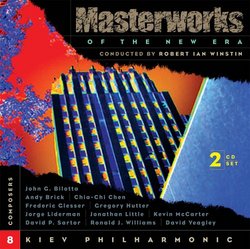A few gems make this a worthy addition to your modern music
Daniel Culveyhouse | San Francisco, CA | 06/25/2006
(3 out of 5 stars)
"Being the eighth CD in the Masterworks series, all conducted by Robert Ian Winstin, this collection of new music offers what you would expect out of 21st century classical- a few gems amidst a sea of incomprehensible music. But it is through collections such as these that we discover new artists, and the three composers in this set which truly stand out are Gregory Hutter, John Bilotta, and Jorge Liderman.
Greory Hutter wrote Urban Collision, based on acoustic dissonance caused by a weekday rush hour in Chicago. One can almost hear the hulking CTA buses belching out exhaust as they slumber down the avenues, depicted by of course, the tubas.
Liderman's Glimpses are a series of twelve tiny movements (but not in twelve tone), all fantastic little treats, and very Argentine in nature with obvious influence from Ginastera.
And lastly, no release of modern music would be complete without a twelve tone masterpiece. John Bilotta's Concerto for Wind Quartet and Orchestra is a tale of a piece very well-written, but not easily performed. The goal is not only for the instrumentalists to capture the structure of the work, but also for the quartet to exude the correct harmonic contrast from the rest of the orchestra. Robert Ian Winstin accepted the challenge.
The result was astonishing. The atmospheric brilliance of the quartet guided the orchestra through the rough terrain of the unyielding tone row. The first movement was their strongest, which includes a textbook (yet clever) cadenza. They also handled the scherzo well as a balanced exposition. The final movement was played too slow and viscous, but regardless, all instrumentalists were still very precise.
As a composition, it is very worthy of study. The marimba's role as the bridge between the quartet and the orchestra is all part of Bilotta's genius, though it didn't come out clearly in this recording. The quartet soloists of the Kiev Philharmonic obviously enjoyed performing the concerto, as they rendered this the best listening material in the entire volume.
Volume 8 of the Masterworks of the New Era series is worth the investment, if only for the three works above. I wish I could praise the rest of the music on the CDs, but I would only do so out of courtesy. I just can't place the ideas behind the other works, and even Hutter's symphonic impression of noise pollution is playable only a few times before it turns annoying."


 Track Listings (11) - Disc #1
Track Listings (11) - Disc #1